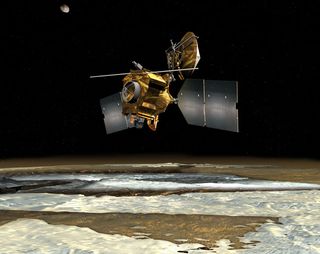New Mars Orbiter Ready for Action

Scientists and engineers are ready to start testing the image-taking skills of the newest spacecraft to swing into orbit around Mars.
NASA's Mars Reconnaissance Orbiter (MRO) is in great shape after its arrival at the planet on March 10. It is now being readied to produce its first images of Mars this week--using the most powerful telescope camera ever sent to another planet.
The University of Arizona's super-powerful High Resolution Imaging Experiment (HiRISE) camera is scheduled to relay first test shots of Mars on March 23 to the HiRISE Operations Center at the University of Arizona in Tucson.
Highly experimental
Alfred McEwen, leader of HiRISE from the University of Arizona cautioned that the first images will be highly experimental. His team will be trying a number of algorithms and systems for the first time, so things could go wrong, McEwen noted in a university press statement. "However, we are sure to learn important lessons about how to operate the spacecraft and HiRISE," he added.
Furthermore, due to the geometries of MRO's early orbit and the start of fall in Mars' southern hemisphere, HiRISE test images may reveal a planetary surface obscured by atmospheric dust or ice hazes. The camera will take pictures of the middle latitudes of the southern hemisphere. That region is where many geologically recent gullies have been seen, features that have been possibly carved by water.
HiRISE images taken during two orbits will be the camera's only photos for the next six months.
Get the Space.com Newsletter
Breaking space news, the latest updates on rocket launches, skywatching events and more!
After the test shots, the camera will be turned off while the spacecraft "aerobrakes"--a process whereby MRO will repeatedly dip into Mars' upper atmosphere to circularize its orbit around the planet.
Aerobraking ahead
"The MRO orbit insertion [on March 10] was exactly as planned," said Jim Graf, Project Manager for MRO at NASA's Jet Propulsion Laboratory (JPL) in Pasadena, California. The orbit period of the spacecraft around Mars is 35.5 hours with closest approach at 265 miles (426 kilometers), he told SPACE.com.
Graf said that MRO is operating nominally and there are no known problems.
The MRO team is working hard to accomplish all the things needed to start aerobraking at the end of the month, he added. This includes taking early test images with several of the instruments; uploading software patches and modifying existing onboard computer files; finishing ground-based risk testing; and conducting operational readiness tests.
Test images taken from several MRO instruments, including HiRISE, are scheduled, Graf said. These are the Context Camera (CTX) that provides wide area views of Mars terrain to help scientists appreciate the context for close-up photos, as well as a trial-run of the Mars Color Imager (MARCI)--a weather camera that eyes clouds and dust storms.
When the images are taken, the spacecraft will be more than three times its normal science orbit distance from Mars, Graf noted. That being the case, the resolution will not be representative of the full capability of the instruments when they are in their final science orbit, he said.
"But it is our first opportunity to fill the imaging apertures completely and with Mars, so it gives us a chance to test procedures and instrument settings," Graf explained. "We then have the five months of active aerobraking to refine procedures and work any issues. Our first priority, of course, remains getting started safely with aerobraking."
- Red Planet Arrival: NASA's MRO Spacecraft Enters Mars Orbit
- Get to Know MRO: Top 10 Facts About NASA's Mars Reconnaissance Orbiter
- Mars Reconnaissance Orbiter Blasts Off for Red Planet
- Hello Mars, Meet 'MR. O': The Mars Reconnaissance Orbiter
- Red Planet Recon: Complete Coverage of NASA's MRO Mission to Mars
Join our Space Forums to keep talking space on the latest missions, night sky and more! And if you have a news tip, correction or comment, let us know at: community@space.com.

Leonard David is an award-winning space journalist who has been reporting on space activities for more than 50 years. Currently writing as Space.com's Space Insider Columnist among his other projects, Leonard has authored numerous books on space exploration, Mars missions and more, with his latest being "Moon Rush: The New Space Race" published in 2019 by National Geographic. He also wrote "Mars: Our Future on the Red Planet" released in 2016 by National Geographic. Leonard has served as a correspondent for SpaceNews, Scientific American and Aerospace America for the AIAA. He has received many awards, including the first Ordway Award for Sustained Excellence in Spaceflight History in 2015 at the AAS Wernher von Braun Memorial Symposium. You can find out Leonard's latest project at his website and on Twitter.
